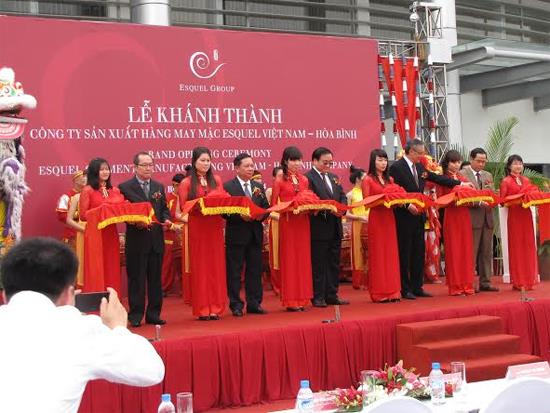Foreign garment firms focusing investment on supply chains

Last week, Hong Kong-based Esquel Group opened its third garment production facility in the northern province of Hoa Binh’s Luong Son industrial park after nearly two years construction.
This is the group’s third factory in Vietnam, following the inauguration of the first in southern Binh Duong province 11 years ago and the second several years later in Dong Nai province.
The new $25 million plant is aimed at boosting the group’s garment exports to $200 million per year and bringing the total headcount at its Vietnam-based factories to about 10,000.
This is one of the first businesses in Vietnam to employ the advanced American standard LEED (Leadership in Energy and Environmental Design) and the lean manufacturing process.
“We have always considered Vietnam a strategic, long-term investment venue and not only to take advantage of Trans-Pacific Partnership (TPP) agreement opportunities,” confirmed John Cheh, CEO of Esquel.
Not long ago, China’s Jiangsu Yulun Textile Group received a license for a $68 million textile, dyeing and yarn plant in Bao Minh industry zone in Nam Dinh province.
According to Nam Dinh Industrial Zone Authority, the factory would come on stream in 2016 producing 9,816 tonnes of yarn, 21.6 million metres of cloth and dye 24 million metres a year.
According to Ho Chi Minh City Export Processing and Industrial Zone Authority (Hepza), another Chinese firm Gain Lucky Limited, which belongs to Shenzhou International, recently committed to a $140 million investment in the city. The company produces garments for brands such as Nike, Adidas and Puma.
Another firm, Forever Glorious under Taiwan’s Sheico Group, announced a landmark $50 million investment to develop a closed weaving-dyeing-making production chain for premium garments.
“It seems the chronic bottlenecks in luring foreign investment into the weaving and dyeing field in terms of intensive investment, experience, technology and workforce have been tackled,” said Dang Phuong Dung, deputy secretary of the Vietnam Textile and Apparel Association (VITAS).
For years, foreign investors adopted simpler routes when entering Vietnam’s textile and garment sector.
They opted to build garment factories for exports that required only modest investments and delivered quick returns, whereas dyeing investments require more capital and may hurt the environment unless proper technology processes are in place.
Last year, Vietnam posted $20 billion in total textile and garment export value whereas the sector’s total import value surpassed $13 billion.
The new trend is expected to help scale up the sector’s localisation rate in the near future.
What the stars mean:
★ Poor ★ ★ Promising ★★★ Good ★★★★ Very good ★★★★★ Exceptional
Latest News
More News
- Double-digit GDP growth within reach with shift to higher-value expansion (January 06, 2026 | 08:33)
- Takeda Vietnam awarded for ongoing support of Vietnam’s sustainability efforts (December 31, 2025 | 21:00)
- Vietnam's retail market tops $269 billion in 2025 amid e-commerce boom (December 31, 2025 | 19:00)
- Stronger legal framework urged as trade fraud surges online (December 31, 2025 | 18:58)
- FPT exports first chip shipment to Japan (December 31, 2025 | 10:47)
- AkzoNobel rolls out sustainability campaign “It All Adds Up” for the wood sector (December 31, 2025 | 09:23)
- Textile apparel firms deliver robust earnings despite global tariff pressures (December 30, 2025 | 10:09)
- Businesses ramp up production as year-end orders surge (December 30, 2025 | 10:05)
- Vietjet chairwoman awarded Labour Hero title (December 29, 2025 | 13:06)
- How to unlock ESG value through green innovation (December 29, 2025 | 10:03)















 Mobile Version
Mobile Version